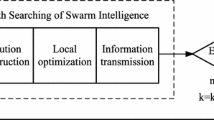Abstract
High-throughput technologies nowadays allow for the acquisition of biological data. These temporal profiles carry topological and kinetic information regarding the biochemical network from which they were drawn. Retrieving this information requires systematic application of both experimental and computational methods. S-systems are nonlinear mathematical approximate models based on the power-law formalism and provide a general framework for the simulation of integrated biological systems exhibiting complex dynamics, such as genetic circuits, signal transduction, and metabolic networks. However, S-systems need lots of iterations to obtain convergent gene expression profiles. For this reason, this study constructed a substitutive approach using artificial neural networks (ANNs) based on the artificial bee colony (ABC) algorithm with learning and training processes. This was used to obtain models and prove that our model (called ABC-NN) certainly is another method to acquire convergent gene expressions, except for S-systems, supported by our testing results.





Similar content being viewed by others
References
Gerner C et al (2002) Concomitant determination of absolute values of cellular protein amounts, synthesis rates, and turnover rates by quantitative proteome profiling. Mol Cell Proteomics 1:528–537
Neves AR et al (2002) Is the glycolytic flux in Lactococcus lactis primarily controlled by the redox charge? J Biol Chem 277:28088–28098
Goodacre R, Harrigan GG (2003) Metabolite profiling: its role in biomarker discovery and gene function analysis. Kluwer, Dordrecht
Voit EO, Radivoyevitch T (2000) Biochemical systems analysis of genome-wide expression data. Bioinformatics 16:1023–1037
Chiang WC, Urban TL, Baldridge GW (1995) A neural network approach to mutual fund net asset value forecasting. Omega-Int J Manage Sci 24:205–210
Cao Q, Leggio K, Schniederjans MJ (2005) A comparison between Fama and French’s model and artificial neural networks in predicting the Chinese stock market. Comput Oper Res 32:2499–2512
Wedge D, Ingram D, McLean D, Mingham C, Bandar Z (2006) On global–local artificial neural networks for function approximation. IEEE Trans Neural Netw 17:942–952
Guille′n A, Pomares H, Rojas I, Gonza′lez J, Herrera LJ, Rojas F, Valenzuela O (2008) Studying possibility in a clustering algorithm for RBFNN design for function approximation. Neural Comput Appl 17:75–89
Chen W, Tian Y-P (2009) Neural network approximation for periodically disturbed functions and applications to control design. Neurocomputing 72:3891–3900
Krzysztof P (2008) Approximation of state-space trajectories by locally recurrent globally feed-forward neural networks. Neural Netw 21:59–64
Socha K, Blum C (2007) An ant colony optimization algorithm for continuous optimization: application to feed-forward neural network training. Neural Comput Appl 3:235–247
Oliveira C, Georgieva P, Rocha F et al (2009) Artificial neural networks for modeling in reaction process systems. Neural Comput Appl 18:15–24
Postalcioglu S, Becerikli Y (2007) Wavelet networks for nonlinear system modeling. Neural Comput Appl 16:433–441
Karaboga D, Basturk B (2007) A powerful and efficient algorithm for numerical function optimization: artificial bee colony (abc) algorithm. J Glob Optim 39:459–471
Karaboga D, Basturk B (2008) On the performance of artificial bee colony (abc) algorithm. Appl Soft Comput 8:687–697
Karaboga D, Akay B (2009) A comparative study of artificial bee colony algorithm. Appl Math Comput 214:108–132
Karaboga D, Ozturk C (2009) Neural networks training by artificial bee colony algorithm on pattern classification. Neural Netw World 19:279–292
Tominaga D, Paul H (2006) Inference of scale-free networks from gene expression time series. J Bioinform Comput Biol 4:503–514
Kikuchi S et al (2003) Dynamic modeling of genetic networks using genetic algorithm and S-system. Bioinformatics 19:643–650
Kimura S et al (2005) Inference of S-system models of genetic networks using a cooperative coevolutionary algorithm. Bioinformatics 21:1154–1163
Voit EO (2000) Computational analysis of biochemical systems. Cambridge University Press, Cambridge
Hornik K, Stinchcombe M, White H (1989) Multilayer feed-forward networks are universal approximators. Neural Netw 2:359–366
Basturk B, Karaboga D (2006) An artificial bee colony (abc) algorithm for numeric function optimization. In: IEEE Swarm intelligence symposium, Indianapolis Indiana USA May
Diebold FX, Mariano RS (1995) Comparing predictive accuracy. J Bus Econ Stat 13:253–263
Kenedy J, Eberhart R (1995) Particle swarm optimization. In Proceedings of the IEEE international conference on neural networks, 1942–1948
Holland JH (1975) Adaptation in natural and artificial systems. University of Michigan Press, Ann Arbor
Acknowledgments
The authors are highly grateful to referees and Dr. John Maclntyre, Editor-in-Chief, for their constructive comments and recommendations, which have significantly improved the presentation of this paper.
Author information
Authors and Affiliations
Corresponding author
Rights and permissions
About this article
Cite this article
Yeh, WC., Hsieh, TJ. Artificial bee colony algorithm-neural networks for S-system models of biochemical networks approximation. Neural Comput & Applic 21, 365–375 (2012). https://doi.org/10.1007/s00521-010-0435-z
Received:
Accepted:
Published:
Issue Date:
DOI: https://doi.org/10.1007/s00521-010-0435-z




